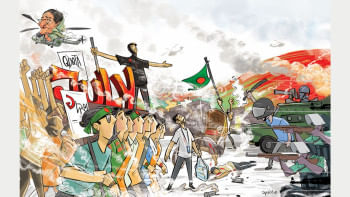Re-visiting the Liberation War Museum

The start of the new beginning
While the Liberation War Museum has in store nearly 21,000 artefacts, only around 1,500 of those were on display in the six galleries. A scarcity of space was becoming an issue for the museum. Considering this and understanding the need for a modernised approach to displaying and preserving, steps for expansion were undertaken.
Back in 2009, a contest was held for the new architectural design of the museum; architects Tanzim Hasan Salim and Naheed Farzana won the first prize for their designs.

Up until 2013, the design only existed as a scale model. That was the year when around an acre of land was acquired and construction finally began. With nationwide donation drives, fund raising campaigns and pledge ceremonies, the Liberation War Museum officially opened its doors at its new home in Agargaon on April 16, 2017.

The Museum — capturing the essence of Liberation
In its outer form, the museum resembles a massive concrete war ship. The 'masts' and the likes are visible from afar while approaching the museum. From ground up, visitors need to take a majestic set of stairs to enter the museum from the front. Side entrances are reserved for special occasions as well as for school visits.
The first thing that catches the eye is the flame surrounded by a small water body. This is a symbol of remembrance and visitors can pay their respect by maintaining one minute of silence. Visitors will need a ticket to enter the galleries; for security purposes bags are not allowed inside.
While entering, there is a life size version of a fighter plane hanging on a side and on the other there is a helicopter. From the first floor, visitors can either use the ramps or take the elevator to reach the next floors.
The first floor houses galleries 1 and 2 alongside the library. The next floor houses galleries 3 and 4 as well as the archives. The original plan for the museum includes the opening of two institutes — The Institute for Liberation War Studies and the Centre for the Study in Genocide and Justice.

Previously, the museum had six rather congested galleries. These have now been put into four spacious ones.
Gallery 1 captures the ancient to the early history of Bengal through the Mughal reigns and right up to the departure of East India Company ending with the Liberation of Bangladesh.
Gallery 2 hosts the events leading to the Liberation War of 1971. Galleries 3 and 4 jointly consist of actual memorabilia of the Liberation War.
Starting from everyday utensils used by the Freedom Fighters to the parachutes used by paratroopers to the original ticket stubs of the Concert for Bangladesh, nothing is amiss. Moreover, Galleries 3 and 4 are made to visualise the plight of the people and the anguish of the refugees at that time.

To highlight various events, on screen videos accompanied by audio is provided for an immersive experience. To create an interactive thought process, Operation Searchlight, one of the darkest nights in human history, is presented in a tunnel-like section.
One of the darkest corners in Gallery 4 is the section where the museum hosts the untold horror stories of the suffering of the women at the hands of vile soldiers of the Pakistani Army.
Most of the displays, especially the paper posters and writings, have been digitised and are shown as printed replicas posted on the walls in enlarged versions. Some of the originals are displayed in protective glass cases for the visitors and are often interchanged. Every single object is labelled with the donating person or family or organisation's name.
The presence of space and concourses in every floor is remarkable as these ensure that the visitors do not clog up the path ways. The walls are encrusted with bespoke murals capturing the spirit of the war.
The ground floor, aside from the fighter plane and the helicopter, boasts of a metal mural of Bangabandhu Sheikh Mujibur Rahman along with the four national leaders.
The ground floor also houses a cafe and a soon-to-be-opened kiosk to sell various products and books related to the War.

A few drawbacks
The lack of signs and an absence of direction for entry are a bit unnerving. Some of the gallery walls already bear scribbles, which is definitely not expected at such a place. Defacing public places like common hoodlums of the dark ages is still a habit of the 21st century touch screen generation. The museum authority must keep a close watch on this.
Originally the Liberation War Museum was a civil society initiative to capture the history of the 1971 Liberation War with community collaboration at its heart. Being transferred to a new home does not mean that the work is over; rather it now provides a greater scope to inspire the generations yet to come.

In its greys and stoic architectural approach, the museum at its new address has captured the embedded sombre tones. All that remains is to recapture the element of life and vibrancy from the old address as the museum continues its quest to uncover the still untold stories.
The new location —
Liberation War Museum (Opposite Orthopaedic Hospital), Plot F, 11A &11B, Sher-e-Bangla Nagor, Dhaka.
It's really hard to miss the museum. Situated right behind the National Institute of Ophthalmology, and surrounded by so many well-known (and frequently travelled) landmark hospitals, the museum is sure to draw in more crowds.


 For all latest news, follow The Daily Star's Google News channel.
For all latest news, follow The Daily Star's Google News channel. 



Comments